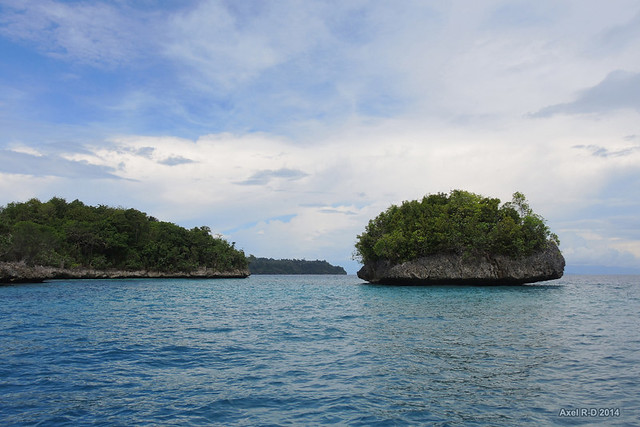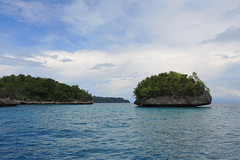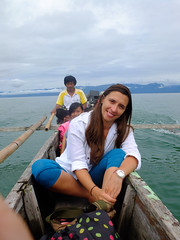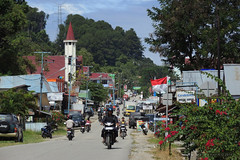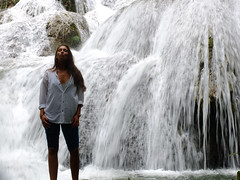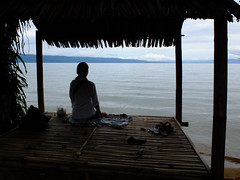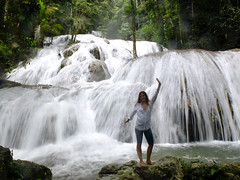Central Sulawesi
Central Sulawesi (Indonesian: Sulawesi Tengah) is a province of Indonesia located at the centre of the island of Sulawesi. The administrative capital and largest city is located in Palu. The 2010 census recorded a population of 2,635,009 for the province, and the 2020 Census recorded 2,985,734, of whom 1,534,706 were male and 1,451,028 were female. The official estimate as at mid 2022 was 3,066,143. Central Sulawesi has an area of , the largest area among all provinces on Sulawesi Island, and has the second-largest population on Sulawesi Island after the province of South Sulawesi. It is bordered by the provinces of Gorontalo to the north, West Sulawesi, South Sulawesi and South East Sulawesi to the south, by Maluku to the east, and by the Makassar Strait to the west. The province is inhabited by many ethnic groups, such as the Kaili, Tolitoli, etc. The official language of the province is Indonesian, which is used for official purposes and inter-ethnic communication, while there are several indigenous language spoken by the Indigenous peoples of Central Sulawesi. Islam is the dominant religion in the province, followed by Christianity which is mostly adhered to by the people in the eastern part of the province.
In the 13th century, several kingdoms had been established in Central Sulawesi such as the Kingdom of Banawa, the Kingdom of Tawaeli, the Kingdom of Sigi, the Kingdom of Bangga, and the Kingdom of Banggai. The influence of Islam on the kingdoms in Central Sulawesi began to be felt in the 16th century. The spread of Islam in Central Sulawesi was a result of the expansion of kingdoms in South Sulawesi. The influence that first came was from the Kingdom of Bone and the Kingdom of Wajo. Dutch traders began arriving in the beginning of the 17th century. The Dutch built several fortifications in present-day Parigi to combat piracy in the region after annexing the region as part of the Dutch East Indies. The province remained part of the Indies for the next three centuries until the Dutch were ousted by the Japanese during World War II. After the Japanese surrendered, the area was incorporated into the new Republic of Indonesia. Initially, the area was part of North Sulawesi before being formed as a separate province on 13 April 1964.
According to UNICEF, Central Sulawesi is a province with a significant number of young people. As many as 1 million people or 35 percent of the total population in this province are children. More than three out of four children live in rural areas. More than 185,000 children (18.2 percent) live below the provincial poverty line in 2015 (Rp. 11,127 per person per day). However, more households are in a vulnerable position and live with income that is slightly above the poverty line. In addition, three-quarters of children experience deprivation in two dimensions non-income poverty or more, with that inequality striking between urban and rural areas.
History
Pre-colonial period
There are over 400 granite megaliths in the area of the Lore Lindu National Park, of which around 30 represent human forms. They vary in size from a few centimetres to approximately . The original purpose of the megaliths is unknown. Other megaliths in the area are large stone pots (Kalamba) accompanied by stone lids (Tutu'na). Various archaeological studies have dated the carvings from between 3000 BC to 1300 AD.
Central Sulawesi Province has many caves, seven of which have ancient pictures and, based on 2011 research by a joint Indonesian and Australian team, the pictures are known to have been drawn at least 40,000 years ago (about the same age as pictures found in the Caves of Monte Castillo, Spain which are known as the oldest ancient pictures in Europe).
Some of the oldest bronze objects are discovered in Central Sulawesi. The Makassar Axe is a 1st-century AD bronze axes probably used as a valuable object in a ceremony. The Kulawi tribe of Central Sulawesi still practice the exchange of heirloom bronze objects e.g. the taiganja, whose basic form has been discovered throughout the eastern part of Indonesia.
Islam reached the region in the 17th century, shortly after the Islamic avowal of Gowa, the powerful kingdom at the south part of Sulawesi island. Areas along the western coast of Central Sulawesi, from Kaili to Tolitoli, were conquered by the Sultanaete of Gowa around the middle of the 16th century under the leadership of King Tunipalangga. The area around the Gulf of Palu is an important center and trade route, coconut oil producer, and "entrance" to the interior of Central Sulawesi. On the other hand, the Gulf of Tomini area is largely under the control of the Kingdom of Parigi.
With the widespread influence of South Sulawesi, Islam spread to the region Islam first spread to the coastal area of Central Sulawesi. In the middle of the 16th century, two kingdoms, namely Buol and Luwuk, accepted Islamic teachings. Since 1540, Buol has been in the form of a sultanate and led by a sultan named Eato Mohammad Tahir.
Colonial era
In the beginning of the 17th century, the Dutch started arriving in Central Sulawesi. Under the pretext of securing his fleet from pirate attacks, the Dutch East India Company (VOC) built fortresses in Parigi and Lambunu. Soon afterwards, the region began to fall into the Dutch sphere of influence. In the 18th century, the Dutch forced the kings of Central Sulawesi to come to Manado and Gorontalo to take an oath of loyalty to the VOC. This would mark the beginning of the Dutch colonial rule in the region for the next three centuries.
Initially, the colonial government paid little attention to the region. In 1824, representatives of the Kingdom of Banawa and the Kingdom of Palu signed the Korte Verklaring (Short Agreement) with the colonial government. Dutch ships began to sail frequently in the southern part of the Gulf of Tomini after 1830.
By the 19th century, most of the interior part of Central Sulawesi still remained unexplored. In 1860, a government official named Johannes Cornelis Wilhelmus Diedericus Adrianus van der Wyck, managed to visit Lake Poso in 1865 – becoming the first European and Dutch to do so. This step was followed by another government official, Willem Jan Maria Michielsen, in 1869. The proposal to occupy the Poso region was rejected – referring to the anti-expansion policies issued by the colonial government at that time. It was not until 1888 that locals of the region began to establish relations with the government in Batavia through a short agreement signed by kings and local authorities, as an anticipatory measure against the possibility of the spread of British political and economic influence in the region.
During this period, Central Sulawesi was under the jurisdiction of Gorontalo Afdeling, based in Gorontalo. G. W. W. C. Baron van Höevell, Gorontalo Resident Assistant, worried that the strong influence of Islam in Gorontalo would extend to the Central Sulawesi – which at that time the population was mostly are adheres to Animism or other Folk religion. He contacted the Dutch missionary institution, the Nederlandsch Zendeling Genootschap (NZG), and asked them to place a missionary in this area. In 1892, the NZG then sent a missionary named Albert Christian Kruyt, who was stationed in Poso. This step was continued in 1894, when the government appointed Eduard van Duyvenbode Varkevisser, as Controller or government official who would become a supervisor and regional leader in Poso.
In 1905, parts of Poso Regency were involved in guerrilla rebellions against Dutch forces, as part of a coordinated Dutch military campaign to annex entire Sulawesi mainland. One of the famous military campaigns was the "pacification" of the Kingdom of Mori in the Wulanderi War that took place in 1907. At the beginning of the 20th century, movements resisting the Dutch colonial rule started appearing. In addition to local movements, movements also based in Java entered. The first organization to establish a branch in Central Sulawesi was the Sarekat Islam (SI), established in Buol Toli-Toli in 1916. Another organization that developed in this area was the Indonesian National Party (PNI) whose branch was established in Buol in 1928. Other organizations opened branches in Central Sulawesi are Muhammadiyah and Islamic Association Party of Indonesia.
The resistance reached its peak on 25 January 1942. A group of resistance fighters led by I.D. Awuy captured government officials such as Controleur Toli-Toli De Hoof, Bestuur Assistant Resident Matata Daeng Masese, and Controleur Buol de Vries. On 1 February 1942, the Indonesian flag was raised for the first time in Toli-Toli. But this situation did not last long because a week later the Dutch troops staged a counter-attack and recaptured Tolitoli.
Contemporary era
Japanese forces landed in Luwuk on 15 May 1942. The Japanese succeeded in expelling the Dutch and taking control of Central Sulawesi in just a short time. During the Japanese occupation, people's lives were increasingly depressed and the misery of all people's activities was only intended to support Japanese warfare. This situation lasted until Japan surrendered to the Allies and was followed by the proclamation of the independence of the Republic of Indonesia. At the beginning of independence, Central Sulawesi was part of the Sulawesi province. The Dutch attempted to return to the region, resulting in a bloody war between the Dutch and the Indonesian. After the Dutch–Indonesian Round Table Conference, the Dutch recognize Indonesia and withdrew from the region.
The present Central Sulawesi was initially part of North Sulawesi with the capital in Manado, but was separated on 13 April 1964.
Between 1999 and 2001 the region has been plagued by inter-religious violence between Muslims and Christians, where over 1,000 people were killed. The Malino II Accord was thus made in 2001. However, riots erupted again in September 2006 on the Christian dominated areas of Central Sulawesi, …
Looking for places related to Central Sulawesi?
Those are other destinations to find places related to Central Sulawesi:
